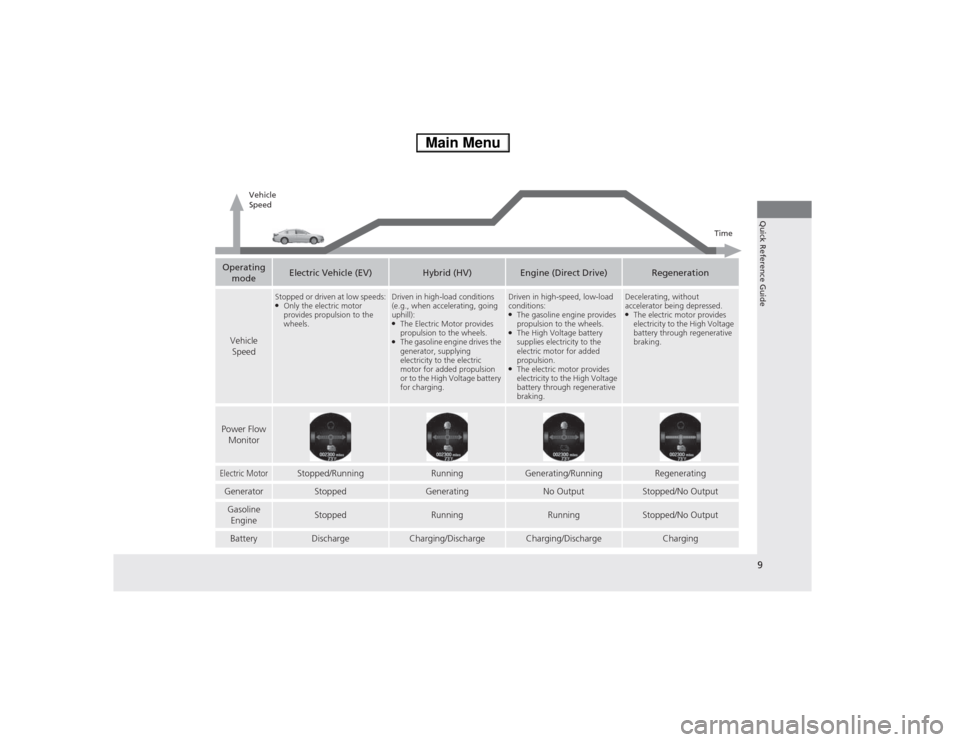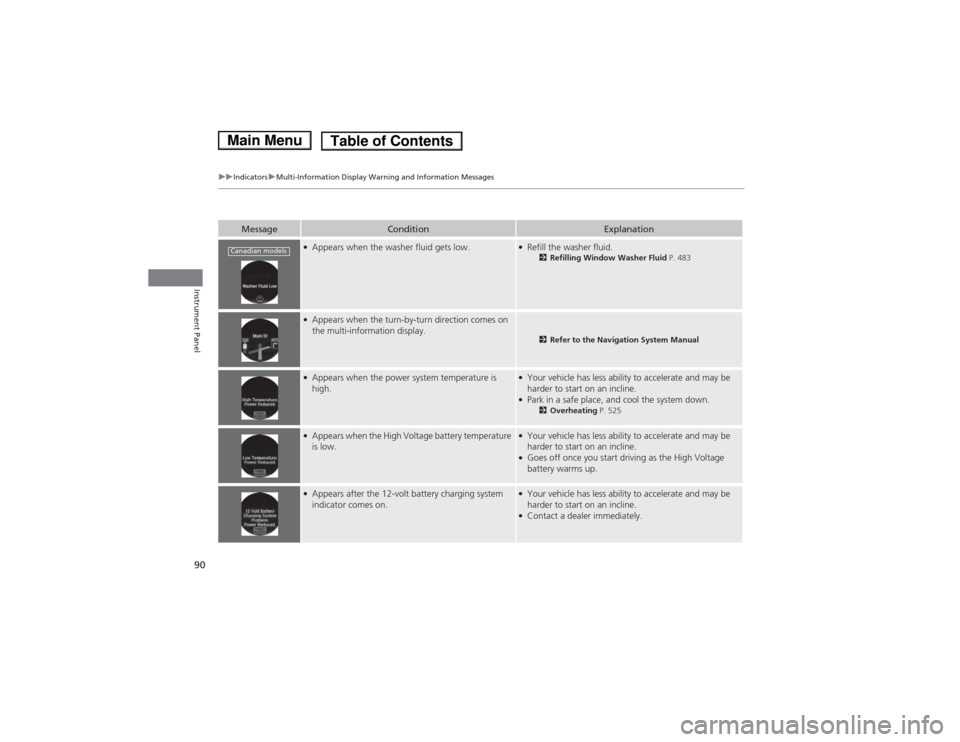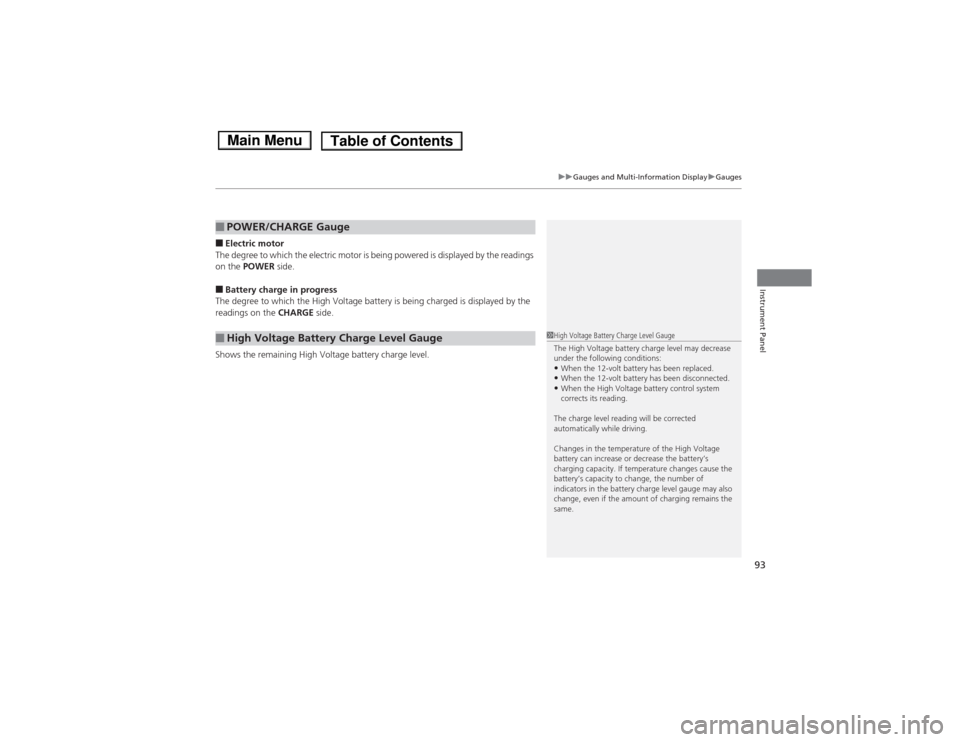2014 HONDA ACCORD HYBRID charging
[x] Cancel search: chargingPage 10 of 561

9
Quick Reference Guide
Operating modeElectric Vehicle (EV)Hybrid (HV)Engine (Direct Drive)Regeneration
Vehicle Speed
Stopped or driven at low speeds: ● Only the electric motor
provides propulsion to the wheels.Driven in high-load conditions
(e.g., when accelerating, going uphill): ●
The Electric Motor provides
propulsion to the wheels.
● The gasoline engine drives the
generator, supplying
electricity to the electric motor for added propulsion
or to the High Voltage battery
for charging.Driven in high-speed, low-load
conditions: ● The gasoline engine provides
propulsion to the wheels.
● The High Voltage battery
supplies electricity to the
electric motor for added
propulsion.
● The electric motor provides
electricity to the High Voltage
battery through regenerative braking.Decelerating, without
accelerator being depressed. ●The electric motor provides
electricity to the High Voltage
battery through regenerative
braking.
Power Flow
Monitor
Electric MotorStopped/RunningRunningGenerating/RunningRegenerating
GeneratorStoppedGeneratingNo OutputStopped/No Output
Gasoline EngineStoppedRunningRunningStopped/No Output
BatteryDischargeCharging/DischargeCharging/DischargeCharging
Vehicle Speed
Time
Main Menu
Page 13 of 561

12
Quick Reference Guide
Safety PrecautionsDo not touch the High Voltage system
Attempting to take a High Voltage system component apart or disconnect one of its wires
can cause severe electrical shock. If the High Voltage system needs maintenance or repair, it
should be performed at a dealer. If a crash occurs ● Be careful of electric shock hazard.
uIf a severe crash damages your vehicle’s High Voltage system, there is a possibility of
electrical shock due to exposed High Voltage components or wires. If this happens, do not
touch any of the High Voltage system components or any of its orange wires. ● Avoid contact with High Voltage battery fluid.
uThe High Voltage battery contains a flammable electrolyte that could leak as a result of
a severe crash. Avoid any skin or eye contact with the electrolyte as it is corrosive. If you
accidentally touch it, flush your eyes or skin with a large quantity of water for at least five
minutes, and seek medical attention immediately. ● Use a fire extinguisher for an electrical fire.
uAttempting to extinguish an electrical fire with a small quantity of water, from a garden
hose for instance, can be dangerous. ● Anytime the vehicle is damaged in an accident, have it repaired by a dealer.
Emergency Shutdown System for the High Voltage System
The emergency shutdown system may activate when the vehicle is impacted by some
incident such as a crash. When this system activate s, the High Voltage system automatically
shuts down, and your vehicle no longer will move under its own power. To return the High
Voltage system back to normal operation, consult a dealer.
Honda collects and recycles High Voltage batt eries used in its vehicles – consult a dealer for
more information.
Do not cover the air intake.
If the air intake is obstructed
during vehicle operation, the High
Voltage battery can become too
hot. To protect the battery, the
system may start to limit the
battery’s output and cause the
power system and 12-volt battery
charging system indicators to come
on. Air Intake
Main Menu
Page 17 of 561

16
Quick Reference Guide
Instrument Panel (P 71)
CanadaU.S.
Low Fuel Indicator
Anti-lock Brake
System ( ABS)
Indicator
Parking Brake
and Brake System
Indicator (Red)
Canada U.S.
READY Indicator
System Indicators
Malfunction
Indicator Lamp
Low Oil Pressure
Indicator
12-Volt Battery
Charging System
Indicator
Vehicle Stability
Assist (VSA ®) System
Indicator VSA ® OFF Indicator
Low Tire Pressure/
TPMS Indicator
Electric Power
Steering (EPS) System
Indicator
Lights IndicatorsLights On Indicator
High Beam Indicator
Immobilizer System
Indicator
Seat Belt Reminder
Indicator EV Indicator
POWER
/CHARGE
Gauge Speedometer
Fuel Gauge
Security System
Alarm Indicator
Shift Lever Position
Indicator
Gauges
(P 92)/Multi-Information Display (P 94)/System Indicators (P 72)
Turn Signal and
Hazard Warning
Indicators
System Indicators High Voltage Battery
Charge Level Gauge
POWER SYSTEM
Indicator
Smart Entry System
Indicator System Message
Indicator
ECON mode
Indicator
Forward Collision
Warning (FCW) Indicator*
Lane Departure Warning (LDW) Indicator* Brake System
Indicator (Amber)
Supplemental
Restraint System
IndicatorEV
Mode Indicator
System Indicators
Multi-Information Display
Main Menu
Page 75 of 561

74
uuIndicatorsu
Instrument Panel
IndicatorNameOn/BlinkingExplanationMessage
Low Oil Pressure
Indicator
●Comes on for a few seconds when
you set the power mode to ON,
then goes off.
● Comes on when the engine oil
pressure is low.●Comes on while driving - Immediately
stop in a safe place. 2If the Low Oil Pressure Indicator
Comes On P. 528
Malfunction Indicator Lamp
●
Comes on when you set the power
mode to ON, and goes off either
when the power system is on or
after several seconds if the vehicle
did not start. If “readiness codes”
have not been set, it blinks five
times before it goes off.
● Comes on if there is a problem
with the emissions control system.
● Blinks when a misfire in the
engine's cylinders is detected.●Readiness codes are part of the on board
diagnostics for the emissions control systems.
2Testing of Readiness Codes P. 543
● Comes on while driving - Have your
vehicle checked by a dealer.
● Blinks while driving - Stop in a safe
place where there are no flammable
objects. Stop the power system for 10
minutes or more, and wait for the engine
to cool down. Then, take the vehicle to a dealer. 2If the Malfunction Indicator Lamp
Comes On or Blinks P. 529
12-Volt Battery
Charging System
Indicator
●
Comes on when you set the power
mode to ON, and goes off when
the power system is on.
● Comes on when the 12-volt
battery is not charging.●
Comes on while driving - Turn off the
climate control system and rear defogger
in order to reduce electricity
consumption. 2If the 12-Volt Battery Charging
System Indicator Comes On P. 528
Main MenuTable of Contents
Page 88 of 561

87
uuIndicatorsuMulti-Information Display Warning and Information Messages
Continued
Instrument Panel
MessageConditionExplanation
●Appears when you close the door with the power
mode in ON without the smart entry remote inside
the vehicle.● Disappears when you bring the smart entry remote
back inside the vehicle and close the door.
2Smart Entry Remote Reminder P. 135
●
Appears when the smart entry remote battery becomes weak.● Replace the battery as soon as possible.
2Replacing the Button Battery P. 503
●
Appears if the smart entry remote battery is too
weak to turn on the power system or the key is not
within operating range to turn on the power system.
A beeper sounds six times.
2 If the Smart Entry Remote Battery is Weak P. 520
●
Appears three seconds after you bring the smart
entry remote in front of the POWER button when
To Start, Hold Remote Near Start Button
appears. To Start Vehicle: Brake + Push appears
sequentially.
2 Changing the Power Mode P. 133
●
Appears when there is a problem with the sensor on the 12-volt battery.
● Appears when the 12-volt battery is not charging.● Have your vehicle checked by a dealer.
2Checking the 12-Volt Battery P. 502
● Appears along with the 12-volt battery charging
system indicator - Turn off the climate control system
and rear defogger to reduce electricity consumption. 2If the 12-Volt Battery Charging System Indicator
Comes On P. 528
Main MenuTable of Contents
Page 91 of 561

90
uuIndicatorsuMulti-Information Display Warning and Information Messages
Instrument Panel
MessageConditionExplanation
●
Appears when the washer fluid gets low.●Refill the washer fluid.
2Refilling Window Washer Fluid P. 483
●
Appears when the turn-by-turn direction comes on
the multi-information display.
2 Refer to the Navigation System Manual
●
Appears when the power system temperature is
high.●Your vehicle has less ability to accelerate and may be
harder to start on an incline.
● Park in a safe place, and cool the system down.
2Overheating P. 525
●
Appears when the High Voltage battery temperature is low.●Your vehicle has less ability to accelerate and may be
harder to start on an incline.
● Goes off once you start driving as the High Voltage
battery warms up.
●Appears after the 12-volt battery charging system
indicator comes on.●Your vehicle has less ability to accelerate and may be
harder to start on an incline.
● Contact a dealer immediately.
Canadian models
Main MenuTable of Contents
Page 94 of 561

93
uuGauges and Multi-Information DisplayuGauges
Instrument Panel
■Electric motor
The degree to which the electric motor is being powered is displayed by the readings on the POWER side.
■ Battery charge in progress
The degree to which the High Voltage battery is being charged is displayed by the
readings on the CHARGE side.
Shows the remaining High Voltage battery charge level.
■POWER/CHARGE Gauge
■High Voltage Battery Charge Level Gauge1High Voltage Battery Charge Level Gauge
The High Voltage battery charge level may decrease
under the following conditions:• When the 12-volt battery has been replaced.
• When the 12-volt battery has been disconnected.
• When the High Voltage battery control system
corrects its reading.
The charge level reading will be corrected
automatically while driving.
Changes in the temperature of the High Voltage
battery can increase or decrease the battery’s
charging capacity. If temperature changes cause the
battery’s capacity to change, the number of
indicators in the battery charge level gauge may also
change, even if the amount of charging remains the
same.
Main MenuTable of Contents
Page 101 of 561

uuGauges and Multi-Information DisplayuMulti-Information Display
100
Instrument Panel
Displays the motor and the engine power flow, indicating what supplies power to
the vehicle, or if the battery is being charged.
■Power Flow Monitor1Power Flow Monitor
While the vehicle is stationary with the engine
running, the following may appear on the multi-
information display.
Power is supplied by the
motor and the engine. Power is only supplied by
the motor.
The motor is charging
the High Voltage battery. Power is only supplied by
the engine.
Main MenuTable of Contents